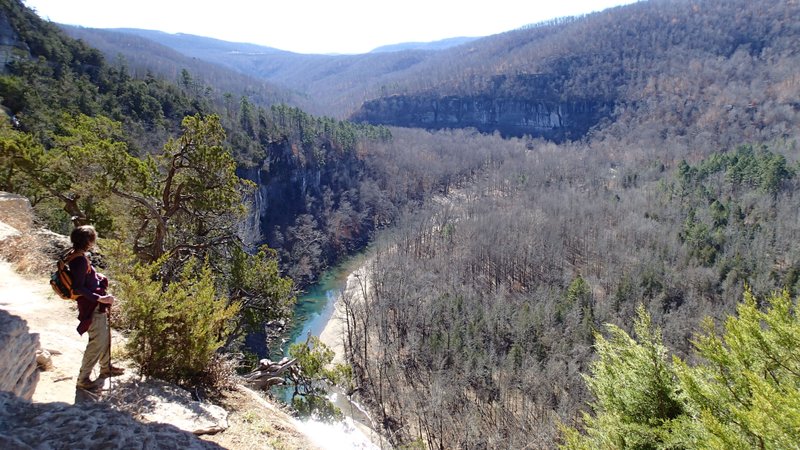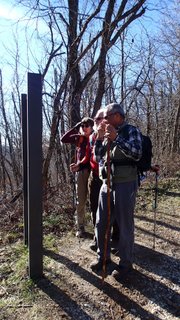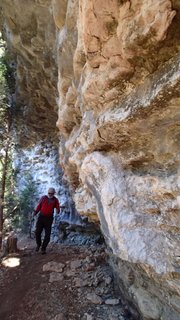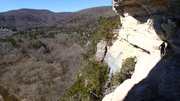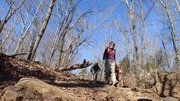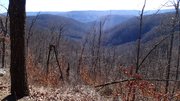Being sure of foot like a mountain goat comes in handy for taking one of the truly spectacular hikes in the Ozarks.
A hike on the Goat Trail treats explorers to lofty views of the river valley and hill country along a narrow trail 300 feet above the Buffalo National River. The trek starts at the Centerpoint trail access on Arkansas 43 north of Ponca. It's a six-mile out and back hike. That's three miles, mostly downhill, out to the views along the bluff, then a tough three-mile hike back to the trail access.
Goat Trail, Big Bluff
The Goat Trail gets its name from feral goats that were sometimes seen on Big Bluff. It’s unlikely hikers will see feral goats today, but some do roam in the Buffalo National River park.
It’s about 60 to 90 minutes of hiking from the Centerpoint trail access to Big Bluff. Allow more time for the hike out, plus ample time to enjoy the scenery out on the bluff.
Directions: From Ponca, go north on Arkansas 43 about three miles. Centerpoint trail access is on the right.
— Buffalo National River
Winter is a prime time to take the hike because so much more of the Buffalo River hill country can be seen when the trees are bare. Stunning views begin only a few steps into the hike. To the right, hikers can see far off into the rugged Buffalo wilderness and the bluffs that cradle the river. These vistas are hidden once the trees leaf out.
A weather forecast of 65 degrees and sunny on Jan. 29 called a quartet of hikers to the Buffalo and a trek on the Goat Trail. They set out from the parking area around 10 a.m. with cameras and lunches in their day packs. The plan was to reach the bluff about lunch time and enjoy fine dining with a view that only nature can provide.
Cameras were clicking before they'd hiked 50 yards. The long views of the Buffalo to the right shift to the left a mile or two into the walk. It's mostly downhill the first half of the hike, but the footing is dicey in spots because of loose rock and mud. A hiking staff is a good idea for extra support on the slick, rocky sections.
Most of the trail follows an old road, so it's easy to see. At one point the trail turns a sharp left with a line of square rocks the size of large tombstones sticking out of the thin soil. Some hikers call this little stretch "stegosaurus" because it resembles the back of a stegosaurus.
After this rocky landmark, hikers are nearing the bluff and should keep an eye out for a trail intersection where a right turn is necessary. The trail continues downhill, then levels out at a clearing in the woods with a large campfire ring. From here, the trail takes a spur to the right. The path starts to follow the bluff through a forest of cedar trees in about 50 yards.
This is no ordinary Buffalo River bluff. It's Big Bluff, which towers 550 feet above the river. The trail runs along the belly of the bluff, halfway between the river and the top. Keep going and the views start to open up.
About a half dozen other hikers were out on the bluff. Two were on their first visit.
"Oh my. I have never, ever seen anything like this," is typically heard. People can be at loss for words to describe the beauty.
Stunning and beautiful as the Goat Trail is, it isn't for everyone. It's not for hikers uncomfortable with heights. Some of the trail along the bluff is narrow, maybe eight feet wide, and a sheer drop to the river. Some choose to go only so far out on the bluff.
It's not a hike suited for young children. The National Park Service says so in its information about the Goat Trail and puts it in all capital letters.
There's the height and a tough, three-mile uphill walk back to the car. Slow and easy with frequent rests is good advice for the hike out.
Winter may be the best season for doing any of the trails in the Buffalo River country, said Caven Clark, with the National Park Service's Buffalo River headquarters in Harrison.
"One plus is you've got no bugs. And a lot of the vistas you'll see you don't get at other times. What I like are seeing icicles, especially when they start to melt and the drops are in the sun. We've also got a lot of bald eagles that you'll only see in winter," he said.
"We get a lot of floaters, too, in the winter," Clark added.
The river level can be good for experienced paddlers prepared to deal with cold water.
No need to hike when it's frigid. There are plenty of mild days during these Arkansas winters. Short sleeves were in fashion the last few miles of the Goat Trail hike.
Flip Putthoff can be reached at [email protected] or on Twitter @NWAFlip
Sports on 02/16/2016

